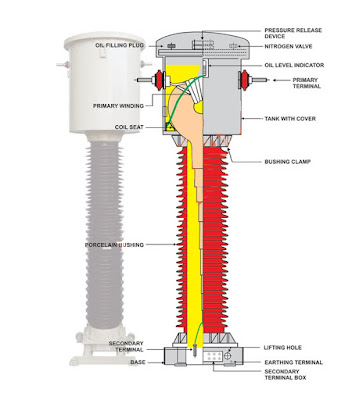Current Transformers are classified as Dead Tank Type and Live Tank Type CTs based on their construction. The term Dead and Live has their own meaning from the view point of potential of Secondary Windings and Core.
Dead Tank itself means that the potential of the Tank of CT is at earth potential i.e. zero as shown in the figure below.
The classification of CT i.e. whether Dead Tank or Live Tank comes from whether the Core and Secondary Winding of CT is located in Dead Tank or Live Tank of CT. If the Core and Secondary Winding is located in Dead Tank, then it is Dead Tank type CT while in case the Core and Secondary Winding is located in Live Tank portion then it is Live Tank type CT. Figure below depicts the Dead Tank type and Live Tank type CT.
Dead Tank type CT:
Carefully observe that Core and Secondary Winding is located in the Live Tank portion.
Now the question arises which type of CT shall be used and what are their advantages and disadvantages?
Basically the use of a particular type of CT depends on the requirement but these days mostly Live Tank CT is used. The advantages and disadvantage will be clear while comparing both types of CT.
Difference between Live Tank and Dead Tank type CT:
|
Sr. No.
|
Live Tank CT
|
Dead Tank CT
|
|
1)
|
In live tank CT, the core with the secondary winding is housed in the top tank which is LIVE.(AT HIGH VOLTAGE)
|
In dead tank CT, the core and secondary winding is housed in the bottom tank which is earthed or DEAD.
|
|
2)
|
In Live Tank, the core and secondary winding is insulated against the high voltage and housed in the top live tank.
|
In Dead Tank CT, the primary winding is brought down to the bottom tank and it is insulated from the earthed tank and cores.
|
|
3)
|
In Live Tank CT, we insulate the core and secondary winding.
|
In Dead Tank CT, we insulate the primary winding.
|
|
4)
|
Only after application of pre-defined insulation on secondary, primary is wound. Application of insulation over wound cores is easy.
|
It is practically difficult to apply the pre-defined insulation over the primary because the primary needs to pass through the wound cores.
|
|
5)
|
Insulation is robust and reliable.
|
Insulation is not robust.
|
|
6)
|
Primary winding is of shortest possible length and its natural shape offers high strength against the short time current dynamic forces.
|
The primary has to pass through the porcelain insulator and the larger length of the primary conductor produces maximum mechanical force during short time dynamic current which might damage the insulation.
|
|
7)
|
Heat generated during short time thermal current is the minimum as primary copper volume is minimum and the heat dissipation is fast as the primary copper is directly in contact with transformer oil.
|
Heat generated during short time thermal current is maximum. Copper volume is maximum and the heat dissipation is slow as the heat need to conduct through the major insulation which is normally a bad conductor of heat.
|
|
8)
|
The transformer is compact and economical.
|
The transformer is bulky and costly.
|
|
9)
|
Primary winding is uniformly distributed around Core, Hence CT is truly low reactance type, which has inherent better transient performance.
|
–
|
|
10)
|
As the length of Primary inside the CT is less (so resistance will be less), the heat produced in the primary will be less.
|
As the length of Primary is more (so resistance will be more) compared to Live Tank type CT, the heating will be more.
|



Good Article , also pls inform CT failure
Good Explanation.Thanks.
Superb thank you so much for the valuable information
Useful Explanation. Thanks!
Excellent and detailed explanation. Thanq very much
Excellent & detailed explanation.
Can you please explain regarding my query. We have 63 MVA, 11 kV / 220 kV power transformer. We have checked IR & PI values. IR values are in Gega Ohm but PI is 1.40 only i.e. less than 2.00. We have also checked BDV & PPM of transformer oil & values of the same are within permissible limit.
Kindly explain the possible problems & remedial action please.
Thanks & Regards,
Santosh Ghodekar
As per NEMA guideline,PI value in the range of 1.25 to 2.0 is considered Fair. For a distribution transformer it is a good value. Refer CEA presentationn. A PI value of <2 indicated problem in Rotating Electrical Machine as per IEEE 43-2000 recommendation on "Recommended Practice for Testing Insulation Resistance of Rotating Machinery"
Thank you very much for detailed explanation.
this is very good article. but dead tank and live tank application not stated properly.
Thank you! Your suggestion will be taken care.